To succeed in excelling at remote dog training jobs, it is crucial to focus on key techniques and utilize remote communication tools effectively. Incorporate positive reinforcement, clicker training, and shaping behaviors to create personalized training programs for each client. Set up a dedicated training area with necessary tools, comfort, and a consistent routine to enhance focus and engagement. Make use of interactive training applications, video conferences, and customized plans for efficient learning and tracking progress. Keep client relationships strong through clear communication, engagement, and efficient processes.
Develop strategies for handling behavioral challenges like fear or aggression using positive reinforcement and customized techniques. Market yourself effectively through a professional website, virtual consultations, and engaging content on online platforms. Grow your remote training business by offering virtual sessions, highlighting services on a professional website, and incorporating online payment systems for ease. Mastering these techniques will guarantee successful outcomes for your remote dog training endeavors.
Key Takeaways
- Utilize virtual platforms for interactive training.
- Offer personalized and effective training experiences.
- Employ positive reinforcement and clicker training methods.
- Develop customized strategies for behavioral challenges.
- Utilize online marketing and client referrals for business growth.
Benefits of Remote Dog Training Jobs
Remote dog training jobs offer trainers the flexibility to work from any location they choose, providing numerous benefits for both professionals and clients. When it comes to training techniques, remote dog trainers have a wide array of tools at their disposal. Through virtual platforms, trainers can implement positive reinforcement, clicker training, and other effective methods to teach dogs new behaviors and commands. These techniques aren't only practical but also highly successful in achieving desired results.
Moreover, virtual training sessions allow trainers to observe both the dog's behavior and the owner's interactions in real-time, enabling them to provide immediate feedback and guidance on proper training techniques. This instant communication helps in addressing any issues promptly and adjusting the training approach as needed. Additionally, remote dog training jobs offer the flexibility to tailor training programs to suit the specific needs and learning styles of individual dogs, ensuring a personalized and effective training experience for each client.
Skills Required for Remote Training
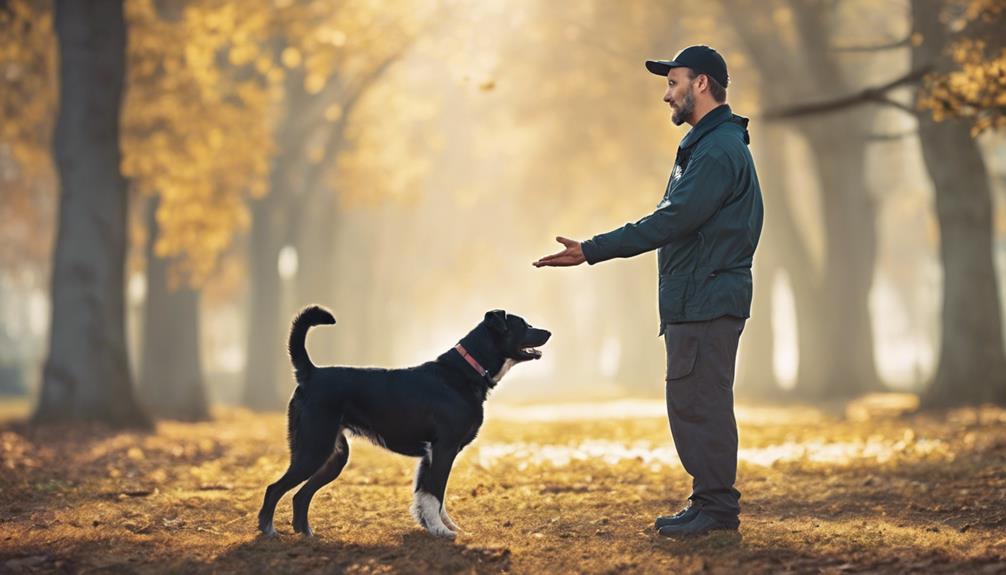
To excel in remote dog training, you must master essential training techniques, utilize remote communication tools effectively, and employ efficient feedback methods.
These skills are vital for effectively guiding dog owners and their pets through virtual training sessions, ensuring successful outcomes and satisfied clients.
Essential Training Techniques
When considering essential training techniques for remote dog training, it's important to focus on skills such as vital reinforcement, clicker training, and shaping behaviors through successive approximations.
These techniques are essential for instilling basic obedience in dogs. Positive reinforcement involves rewarding desirable behaviors to encourage their repetition. Clicker training uses a distinct sound to mark correct actions instantly, aiding in clear communication with your canine companion. Shaping behaviors through successive approximations means breaking down complex actions into smaller steps, gradually guiding your dog towards the desired behavior.
Remote Communication Tools
Using video conferencing platforms effectively is essential for conducting remote dog training sessions. As a Certified Dog Trainer, mastering remote communication tools is key to successful virtual sessions. Here are three important skills to hone in this area:
- Proficiency in Screen-Sharing: Being able to share your screen allows you to demonstrate training techniques visually, ensuring both the dog and owner understand clearly.
- Utilization of Virtual Whiteboards: Virtual whiteboards are excellent tools for illustrating concepts and strategies, enhancing the training experience for all participants.
- Clear Verbal Communication: Effective verbal communication is crucial for providing instructions and feedback during remote sessions, helping you guide owners and modify behaviors effectively.
Effective Feedback Methods
Mastering effective feedback methods is essential for success in remote dog training roles, requiring skills that allow for precise guidance and tailored support to clients. Professional dog trainers can utilize various feedback techniques to enhance their remote training sessions. Here is a table summarizing some effective methods:
| Feedback Method | Description | Benefit |
|---|---|---|
| Video Recordings | Capture training sessions for visual feedback to clients | Provides clear demonstration of techniques |
| Real-time Communication Tools (e.g., Video Calls) | Offer immediate feedback during sessions by observing clients' techniques | Allows for instant corrections and guidance |
| Written Feedback via Email or Messaging Platforms | Explain training methods, corrections, and improvements in detail for remote clients | Offers clients with detailed guidance and instructions |
Implementing these feedback methods will help professional dog trainers deliver high-quality remote training.
Setting Up a Home Training Space
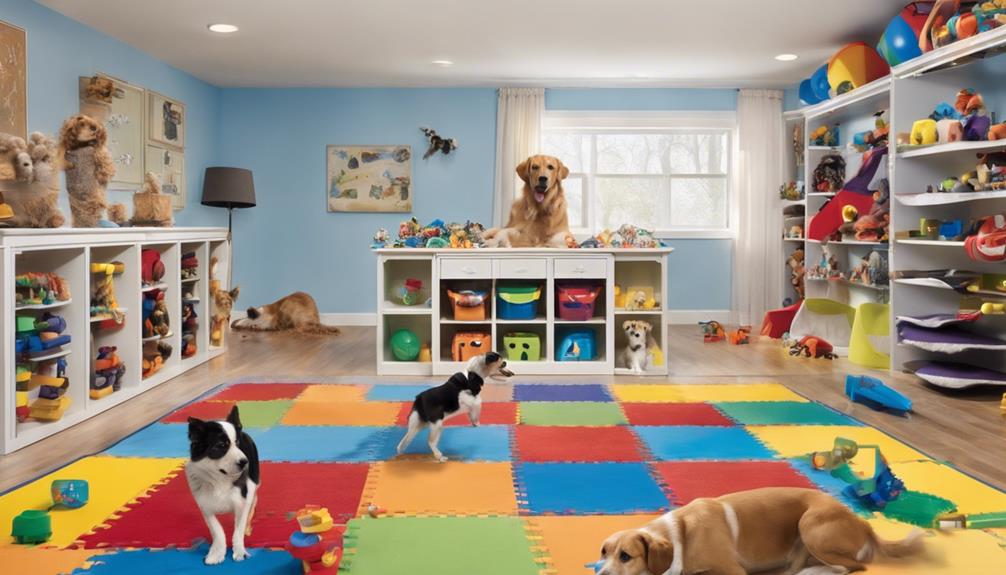
To establish an effective home training space for your dog, designate a quiet, distraction-free area in your home. This will help ensure your furry friend's focus and engagement during training sessions. Here are three essential steps to optimize your training space:
- Equip the Space:
Fill the designated area with essential training tools such as treats, toys, clickers, and training mats. These items will facilitate effective learning and help maintain your dog's interest throughout the training process.
- Ensure Comfort:
Proper lighting and ventilation are vital for creating a comfortable environment for both you and your dog. A well-lit and well-ventilated space will enhance the training experience and make it more enjoyable for everyone involved.
- Establish Routine:
Use positive reinforcement techniques and clear communication to create a positive association with the training area. Maintain a consistent schedule for training sessions in the designated space to establish a routine and reinforce good behavior. Consistency is key in dog obedience training, and a dedicated training space will aid in achieving mastery.
Virtual Training Tools and Platforms
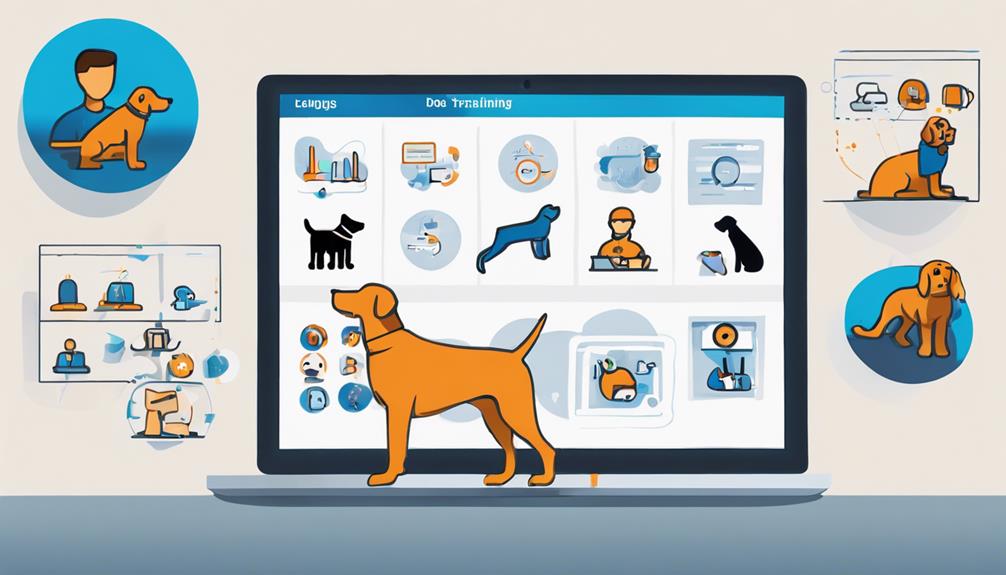
When exploring virtual training tools and platforms for dog training, consider using interactive training apps and video conference sessions.
These tools can help you engage with clients effectively and provide hands-on guidance remotely.
Interactive Training Apps
Interactive training apps provide virtual tools and platforms for remote dog training sessions, offering a variety of engaging exercises and activities for both dogs and owners. These apps utilize positive reinforcement techniques to encourage desired behaviors in your furry friend.
Here are three key benefits of interactive training apps:
- Customized Training Plans: These apps allow you to tailor training sessions to suit your dog's specific needs and abilities, ensuring effective learning.
- Real-time Feedback: Receive immediate feedback on your training techniques and your dog's progress, enabling you to make necessary adjustments promptly.
- Progress Tracking: Keep track of your dog's training milestones and improvements over time, helping you stay motivated and focused on your training goals.
Video Conference Sessions
Virtual training tools such as Zoom, Skype, and Google Meet facilitate remote dog training sessions from any location with internet access. These platforms offer a seamless way for dog trainers to conduct sessions virtually, allowing for real-time interaction and feedback.
Specialized platforms like PetPro Connect and TrainAway enhance the experience by providing features tailored specifically for dog training, ensuring interactive and engaging sessions. Through video conference sessions, trainers can demonstrate training techniques live, offering clients a firsthand view of the training process.
Additionally, remote dog training expands a trainer's reach globally, enabling connections with clients from different locations. These tools also streamline the process with secure payment options and convenient scheduling features, making remote dog training sessions efficient and effective.
Building Client Relationships Remotely
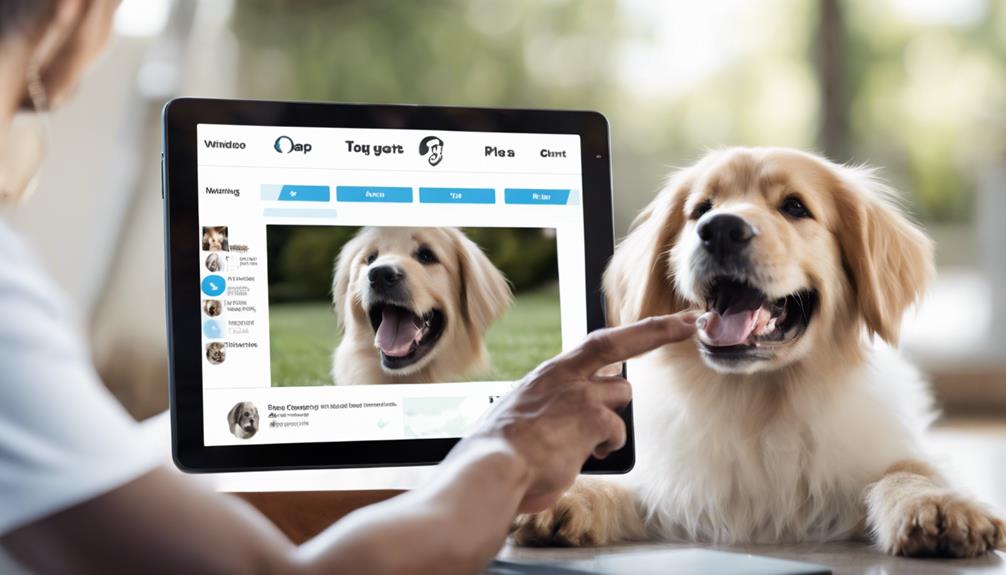
Enhancing client relationships remotely in dog training involves leveraging video conferencing tools and digital resources to provide personalized guidance and support. To excel in this aspect of your job, consider the following strategies:
- Virtual Consultations: Schedule regular virtual consultations with clients to discuss their progress, address concerns, and offer tailored advice based on their specific needs. Utilize platforms like Zoom or Skype for face-to-face interactions without physical presence.
- Digital Training Plans: Send detailed training plans and resources electronically to empower clients to continue the training at home effectively. This guarantees consistency and enables clients to refer back to the materials whenever needed.
- Ongoing Communication: Maintain regular contact through email, phone calls, or messaging apps to offer continuous support and guidance. Respond promptly to inquiries and provide encouragement to keep clients motivated and engaged in the training process.
Handling Behavioral Challenges Online
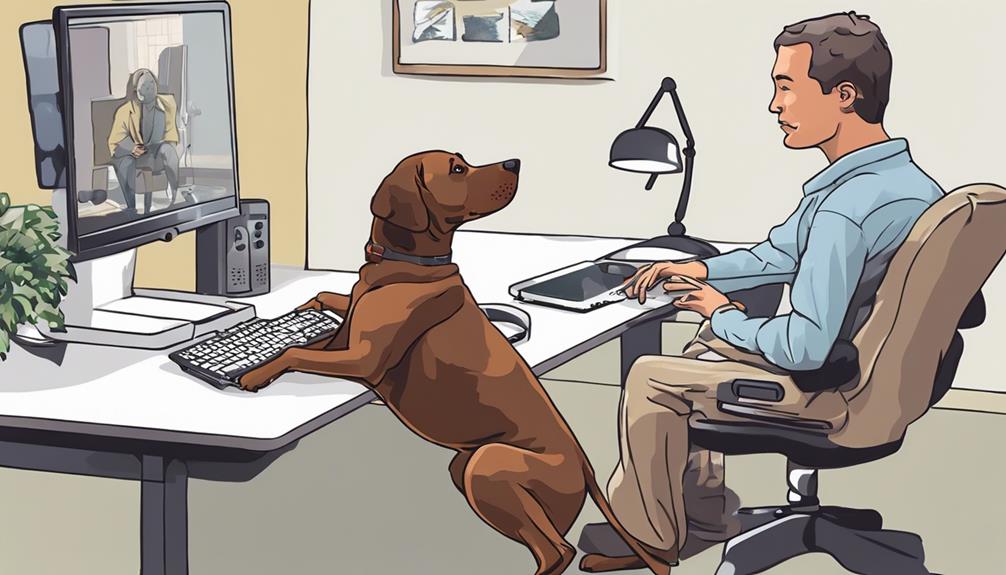
To effectively address behavioral challenges in remote dog training, understanding canine body language and behavior cues is essential. When dealing with issues like fear, aggression, separation anxiety, or leash reactivity, a solid grasp of these signals will be your guiding light.
In your training program, focus on positive reinforcement techniques and structured plans tailored to each dog's needs. Utilize video calls, live demonstrations, and detailed instructions to work through problems effectively from a distance. Collaborate closely with pet owners to develop customized strategies for managing and modifying problematic behaviors.
Marketing Yourself as a Remote Trainer

Showcasing your expertise through online platforms and social media is key to attracting clients seeking remote dog training services. Here are three essential strategies to effectively market yourself as a remote trainer:
- Professional Website: Create a professional website that highlights your qualifications, experience, and unique training methods. This online platform will serve as a hub for potential clients to learn more about your services and establish your credibility in the remote dog training industry.
- Virtual Consultations: Offer virtual consultations and training sessions to reach clients globally. By providing remote services, you can cater to a wider audience and expand your remote training business beyond geographical limitations.
- Engaging Content: Develop engaging and informative content like blog posts, videos, or social media posts to educate pet owners on the benefits of remote dog training. Creating valuable content won't only attract potential clients but also showcase your expertise in the field.
Growing Your Remote Training Business
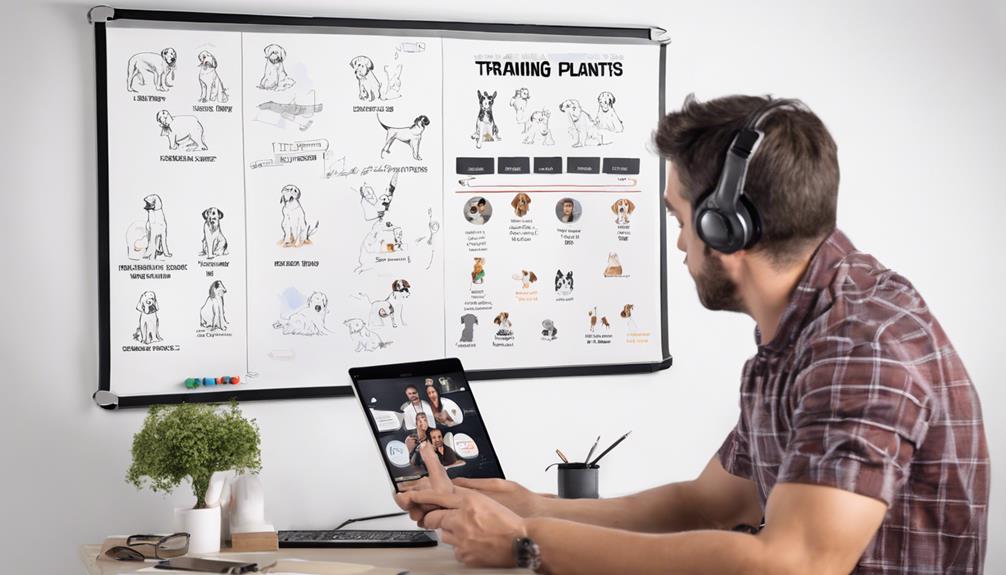
Expanding your remote training business involves leveraging online platforms and social media to reach a broader audience. Utilize platforms like Instagram, Facebook, and YouTube to showcase your expertise and attract potential clients. Offer virtual training sessions via video calls to provide personalized instruction, regardless of location. Develop a professional website highlighting your services, qualifications, and success stories to establish credibility. Incorporate online payment systems for seamless billing and scheduling. Harness the power of email marketing and client referrals to expand your customer base and solidify your online presence.
Collaborating with organizations like the Humane Society can also boost your business. Partnering with the Humane Society can provide credibility, increase visibility, and attract clients who value humane training practices. Consider offering discounted services for rescued animals or collaborating on educational events. By expanding your reach through online platforms, strategic partnerships, and exceptional service, you can grow your remote training business effectively.
Frequently Asked Questions
Can You Make 6 Figures as a Dog Trainer?
You can make 6 figures as a dog trainer by specializing in services like service dog training, building a strong online presence, and developing a referral network. Continuous education and staying updated with industry trends are key.
Can You Make a Career Out of Dog Training?
You can build a rewarding career in dog training by honing your skills, gaining experience, and obtaining certifications. Like a skilled painter creating a masterpiece, with dedication and expertise, you can make a successful livelihood training dogs.
How to Make Money Training Dogs?
To make money training dogs, hone your skills, get certified, and seek out remote opportunities with reputable organizations. Offer your expertise, build a solid reputation, and market your services to attract clients willing to invest in their furry companions.
Can You Make Money Training Guide Dogs?
Yes, you can make money training guide dogs. Specialized skills in obedience, socialization, and task training are essential. Guide dog trainers help visually impaired individuals gain independence. Organizations offer apprenticeships or certification programs for aspiring trainers.
What Are the Transferable Skills from Police Dog Training to Remote Dog Training?
The skills for police dog training, such as obedience, scent detection, and agility, are highly transferable to remote dog training. Remote trainers can utilize these skills to effectively communicate with dogs and teach them commands and behaviors from a distance, creating well-behaved and responsive pets.
Can the skills and techniques used in army dog training be applied to remote dog training jobs?
The techniques and skills used in top army dog training jobs can absolutely be applied to remote dog training jobs. The ability to effectively communicate, establish trust, and utilize positive reinforcement methods are crucial in both settings. The key is adapting these tactics to fit the unique challenges of remote training.
Conclusion
Mastering remote dog training jobs can be a rewarding career path. Did you know that 83% of pet owners are more likely to seek out virtual training options for their furry friends?
By developing your skills, setting up a dedicated training space, utilizing virtual tools, and building strong client relationships, you can successfully grow your remote training business.
With dedication and perseverance, you can make a positive impact on the lives of dogs and their owners from the comfort of your own home.










